Employee Engagement Benefits and Strategies: A Report
VerifiedAdded on 2020/04/21
|12
|4207
|48
Report
AI Summary
This report focuses on employee engagement within a Malaysian pharmaceutical company, emphasizing its importance for organizational success in a competitive environment. It explores the potential benefits and outcomes of high employee engagement, including enhanced employee satisfaction, increased productivity, improved employee retention and recruitment, fostering innovation, boosting profitability, and enhancing employee loyalty. The report delves into various factors influencing employee engagement, such as strategic alignment, trust in leadership, peer culture, personal influence, manager-employee relationships, career support, job design, development opportunities, and fair pay. Furthermore, it outlines various employee engagement strategies, highlighting the significance of retaining employees, creating a flexible work environment, and ensuring the right employees are in place. The report stresses the importance of these strategies in driving business success, customer satisfaction, and overall organizational growth within the pharmaceutical sector.
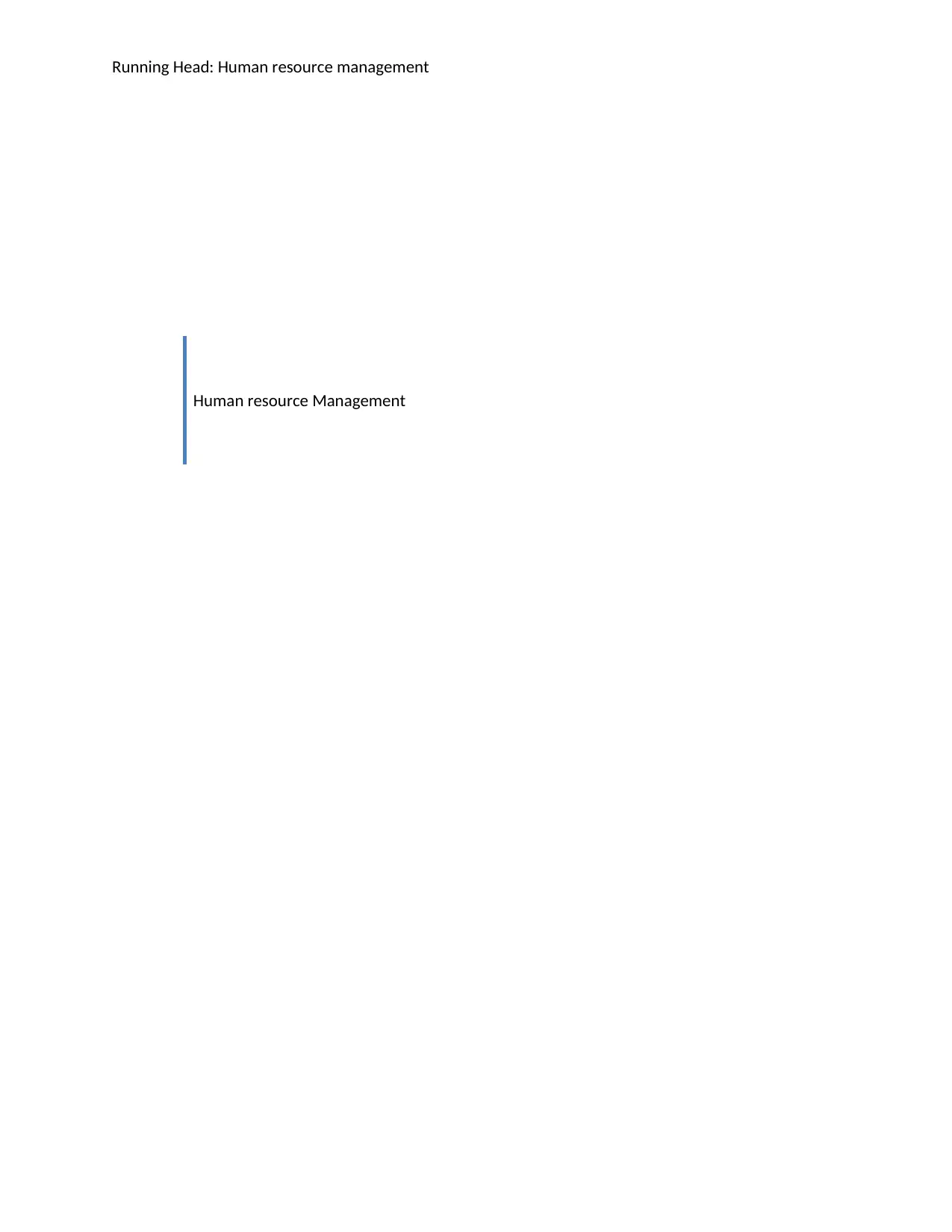
Running Head: Human resource management
Human resource Management
Human resource Management
Paraphrase This Document
Need a fresh take? Get an instant paraphrase of this document with our AI Paraphraser
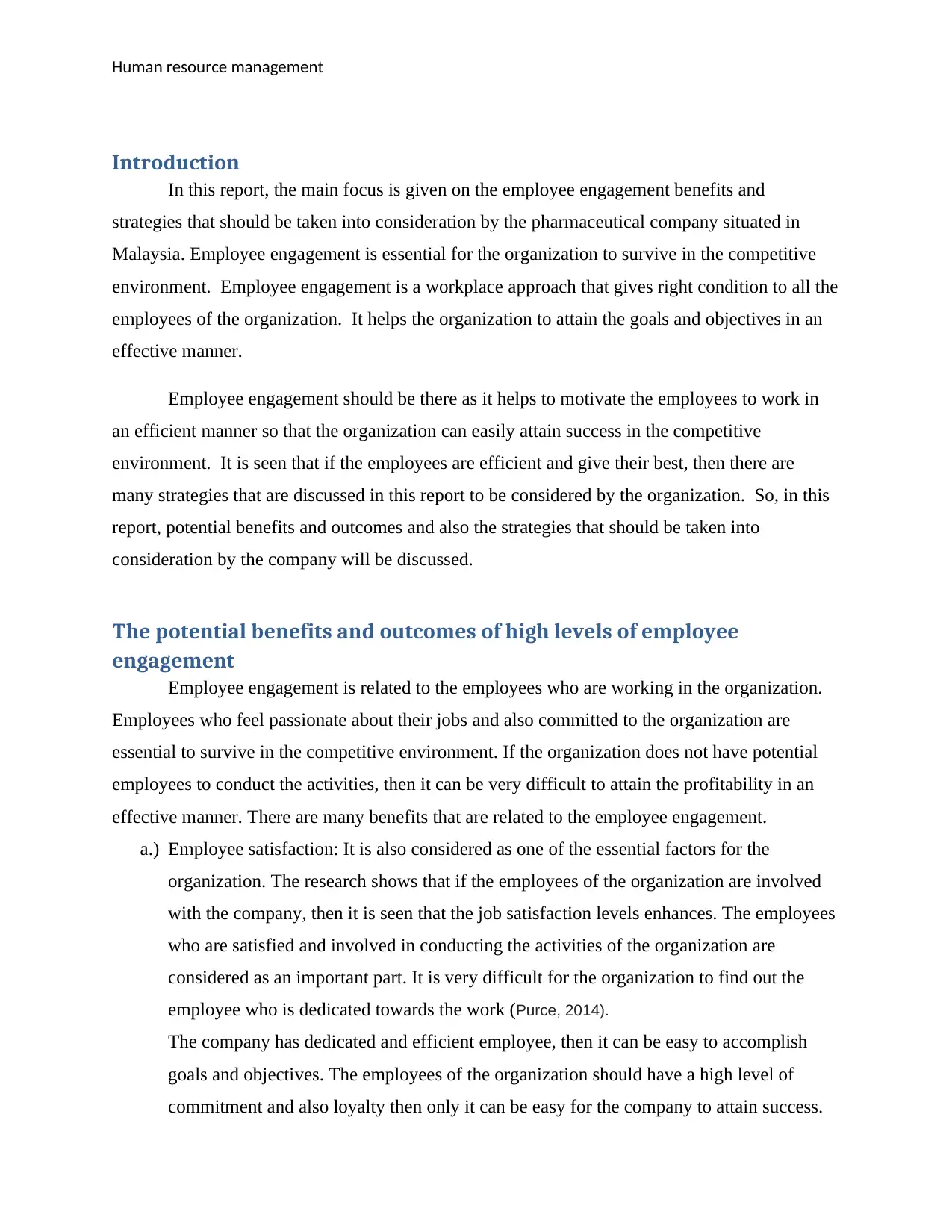
Human resource management
Introduction
In this report, the main focus is given on the employee engagement benefits and
strategies that should be taken into consideration by the pharmaceutical company situated in
Malaysia. Employee engagement is essential for the organization to survive in the competitive
environment. Employee engagement is a workplace approach that gives right condition to all the
employees of the organization. It helps the organization to attain the goals and objectives in an
effective manner.
Employee engagement should be there as it helps to motivate the employees to work in
an efficient manner so that the organization can easily attain success in the competitive
environment. It is seen that if the employees are efficient and give their best, then there are
many strategies that are discussed in this report to be considered by the organization. So, in this
report, potential benefits and outcomes and also the strategies that should be taken into
consideration by the company will be discussed.
The potential benefits and outcomes of high levels of employee
engagement
Employee engagement is related to the employees who are working in the organization.
Employees who feel passionate about their jobs and also committed to the organization are
essential to survive in the competitive environment. If the organization does not have potential
employees to conduct the activities, then it can be very difficult to attain the profitability in an
effective manner. There are many benefits that are related to the employee engagement.
a.) Employee satisfaction: It is also considered as one of the essential factors for the
organization. The research shows that if the employees of the organization are involved
with the company, then it is seen that the job satisfaction levels enhances. The employees
who are satisfied and involved in conducting the activities of the organization are
considered as an important part. It is very difficult for the organization to find out the
employee who is dedicated towards the work (Purce, 2014).
The company has dedicated and efficient employee, then it can be easy to accomplish
goals and objectives. The employees of the organization should have a high level of
commitment and also loyalty then only it can be easy for the company to attain success.
Introduction
In this report, the main focus is given on the employee engagement benefits and
strategies that should be taken into consideration by the pharmaceutical company situated in
Malaysia. Employee engagement is essential for the organization to survive in the competitive
environment. Employee engagement is a workplace approach that gives right condition to all the
employees of the organization. It helps the organization to attain the goals and objectives in an
effective manner.
Employee engagement should be there as it helps to motivate the employees to work in
an efficient manner so that the organization can easily attain success in the competitive
environment. It is seen that if the employees are efficient and give their best, then there are
many strategies that are discussed in this report to be considered by the organization. So, in this
report, potential benefits and outcomes and also the strategies that should be taken into
consideration by the company will be discussed.
The potential benefits and outcomes of high levels of employee
engagement
Employee engagement is related to the employees who are working in the organization.
Employees who feel passionate about their jobs and also committed to the organization are
essential to survive in the competitive environment. If the organization does not have potential
employees to conduct the activities, then it can be very difficult to attain the profitability in an
effective manner. There are many benefits that are related to the employee engagement.
a.) Employee satisfaction: It is also considered as one of the essential factors for the
organization. The research shows that if the employees of the organization are involved
with the company, then it is seen that the job satisfaction levels enhances. The employees
who are satisfied and involved in conducting the activities of the organization are
considered as an important part. It is very difficult for the organization to find out the
employee who is dedicated towards the work (Purce, 2014).
The company has dedicated and efficient employee, then it can be easy to accomplish
goals and objectives. The employees of the organization should have a high level of
commitment and also loyalty then only it can be easy for the company to attain success.
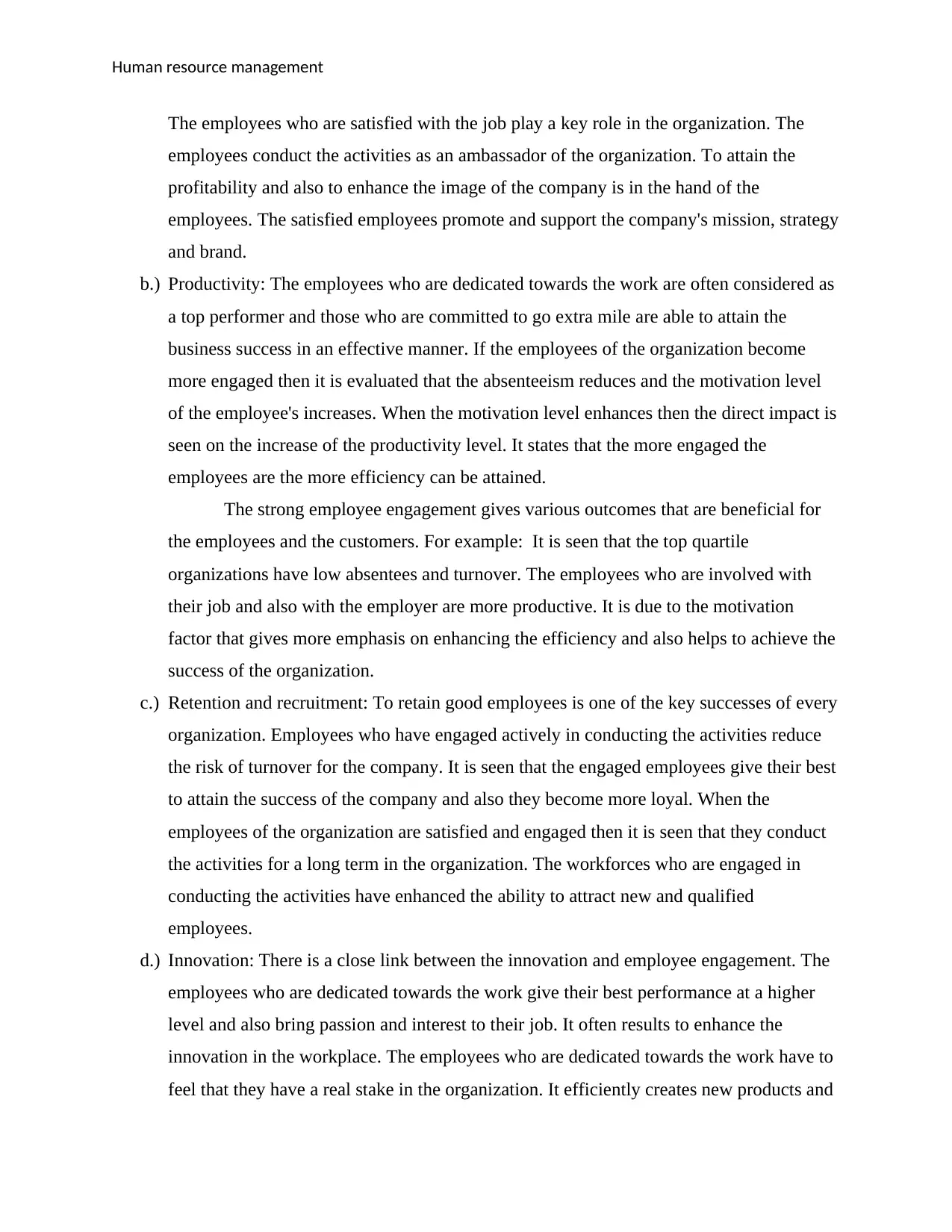
Human resource management
The employees who are satisfied with the job play a key role in the organization. The
employees conduct the activities as an ambassador of the organization. To attain the
profitability and also to enhance the image of the company is in the hand of the
employees. The satisfied employees promote and support the company's mission, strategy
and brand.
b.) Productivity: The employees who are dedicated towards the work are often considered as
a top performer and those who are committed to go extra mile are able to attain the
business success in an effective manner. If the employees of the organization become
more engaged then it is evaluated that the absenteeism reduces and the motivation level
of the employee's increases. When the motivation level enhances then the direct impact is
seen on the increase of the productivity level. It states that the more engaged the
employees are the more efficiency can be attained.
The strong employee engagement gives various outcomes that are beneficial for
the employees and the customers. For example: It is seen that the top quartile
organizations have low absentees and turnover. The employees who are involved with
their job and also with the employer are more productive. It is due to the motivation
factor that gives more emphasis on enhancing the efficiency and also helps to achieve the
success of the organization.
c.) Retention and recruitment: To retain good employees is one of the key successes of every
organization. Employees who have engaged actively in conducting the activities reduce
the risk of turnover for the company. It is seen that the engaged employees give their best
to attain the success of the company and also they become more loyal. When the
employees of the organization are satisfied and engaged then it is seen that they conduct
the activities for a long term in the organization. The workforces who are engaged in
conducting the activities have enhanced the ability to attract new and qualified
employees.
d.) Innovation: There is a close link between the innovation and employee engagement. The
employees who are dedicated towards the work give their best performance at a higher
level and also bring passion and interest to their job. It often results to enhance the
innovation in the workplace. The employees who are dedicated towards the work have to
feel that they have a real stake in the organization. It efficiently creates new products and
The employees who are satisfied with the job play a key role in the organization. The
employees conduct the activities as an ambassador of the organization. To attain the
profitability and also to enhance the image of the company is in the hand of the
employees. The satisfied employees promote and support the company's mission, strategy
and brand.
b.) Productivity: The employees who are dedicated towards the work are often considered as
a top performer and those who are committed to go extra mile are able to attain the
business success in an effective manner. If the employees of the organization become
more engaged then it is evaluated that the absenteeism reduces and the motivation level
of the employee's increases. When the motivation level enhances then the direct impact is
seen on the increase of the productivity level. It states that the more engaged the
employees are the more efficiency can be attained.
The strong employee engagement gives various outcomes that are beneficial for
the employees and the customers. For example: It is seen that the top quartile
organizations have low absentees and turnover. The employees who are involved with
their job and also with the employer are more productive. It is due to the motivation
factor that gives more emphasis on enhancing the efficiency and also helps to achieve the
success of the organization.
c.) Retention and recruitment: To retain good employees is one of the key successes of every
organization. Employees who have engaged actively in conducting the activities reduce
the risk of turnover for the company. It is seen that the engaged employees give their best
to attain the success of the company and also they become more loyal. When the
employees of the organization are satisfied and engaged then it is seen that they conduct
the activities for a long term in the organization. The workforces who are engaged in
conducting the activities have enhanced the ability to attract new and qualified
employees.
d.) Innovation: There is a close link between the innovation and employee engagement. The
employees who are dedicated towards the work give their best performance at a higher
level and also bring passion and interest to their job. It often results to enhance the
innovation in the workplace. The employees who are dedicated towards the work have to
feel that they have a real stake in the organization. It efficiently creates new products and
⊘ This is a preview!⊘
Do you want full access?
Subscribe today to unlock all pages.

Trusted by 1+ million students worldwide
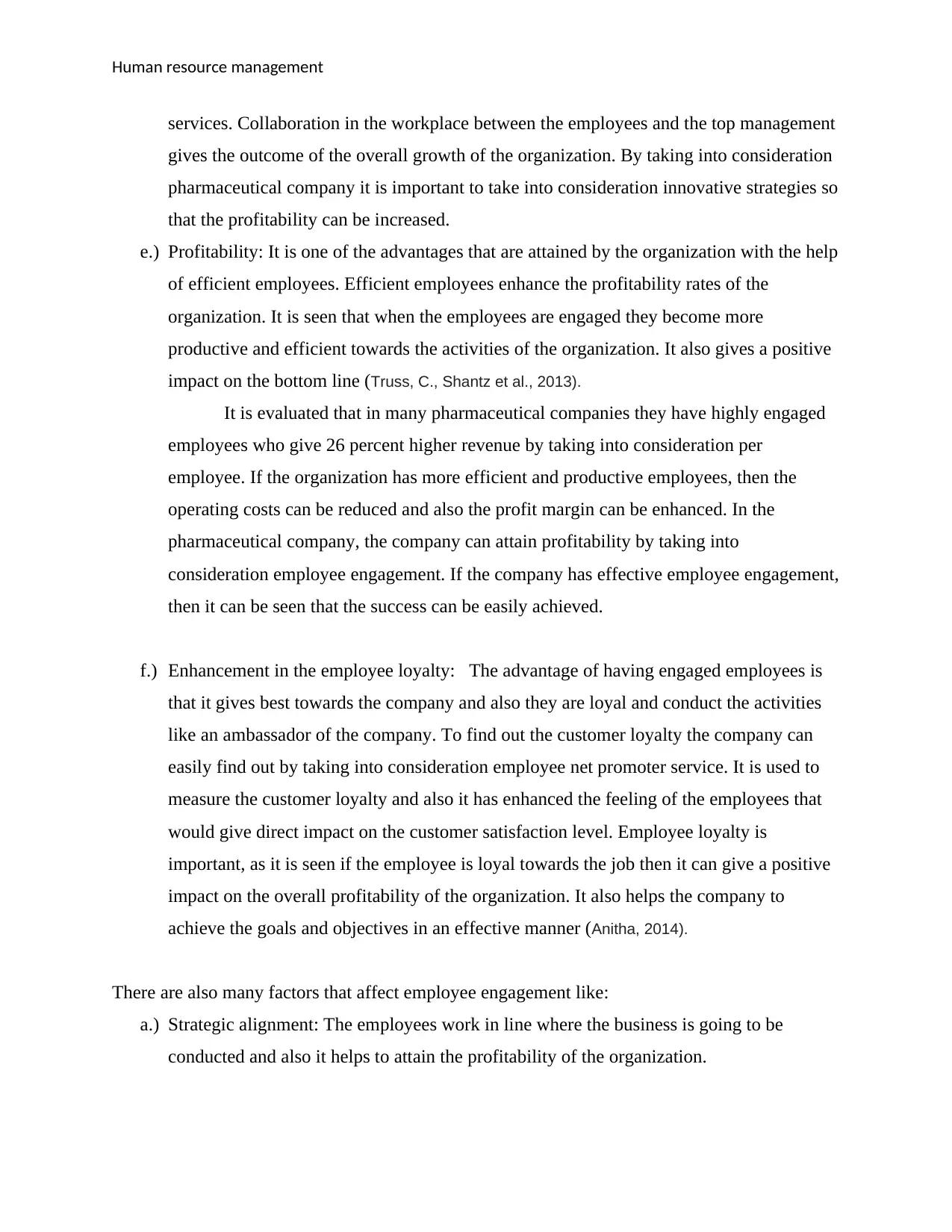
Human resource management
services. Collaboration in the workplace between the employees and the top management
gives the outcome of the overall growth of the organization. By taking into consideration
pharmaceutical company it is important to take into consideration innovative strategies so
that the profitability can be increased.
e.) Profitability: It is one of the advantages that are attained by the organization with the help
of efficient employees. Efficient employees enhance the profitability rates of the
organization. It is seen that when the employees are engaged they become more
productive and efficient towards the activities of the organization. It also gives a positive
impact on the bottom line (Truss, C., Shantz et al., 2013).
It is evaluated that in many pharmaceutical companies they have highly engaged
employees who give 26 percent higher revenue by taking into consideration per
employee. If the organization has more efficient and productive employees, then the
operating costs can be reduced and also the profit margin can be enhanced. In the
pharmaceutical company, the company can attain profitability by taking into
consideration employee engagement. If the company has effective employee engagement,
then it can be seen that the success can be easily achieved.
f.) Enhancement in the employee loyalty: The advantage of having engaged employees is
that it gives best towards the company and also they are loyal and conduct the activities
like an ambassador of the company. To find out the customer loyalty the company can
easily find out by taking into consideration employee net promoter service. It is used to
measure the customer loyalty and also it has enhanced the feeling of the employees that
would give direct impact on the customer satisfaction level. Employee loyalty is
important, as it is seen if the employee is loyal towards the job then it can give a positive
impact on the overall profitability of the organization. It also helps the company to
achieve the goals and objectives in an effective manner (Anitha, 2014).
There are also many factors that affect employee engagement like:
a.) Strategic alignment: The employees work in line where the business is going to be
conducted and also it helps to attain the profitability of the organization.
services. Collaboration in the workplace between the employees and the top management
gives the outcome of the overall growth of the organization. By taking into consideration
pharmaceutical company it is important to take into consideration innovative strategies so
that the profitability can be increased.
e.) Profitability: It is one of the advantages that are attained by the organization with the help
of efficient employees. Efficient employees enhance the profitability rates of the
organization. It is seen that when the employees are engaged they become more
productive and efficient towards the activities of the organization. It also gives a positive
impact on the bottom line (Truss, C., Shantz et al., 2013).
It is evaluated that in many pharmaceutical companies they have highly engaged
employees who give 26 percent higher revenue by taking into consideration per
employee. If the organization has more efficient and productive employees, then the
operating costs can be reduced and also the profit margin can be enhanced. In the
pharmaceutical company, the company can attain profitability by taking into
consideration employee engagement. If the company has effective employee engagement,
then it can be seen that the success can be easily achieved.
f.) Enhancement in the employee loyalty: The advantage of having engaged employees is
that it gives best towards the company and also they are loyal and conduct the activities
like an ambassador of the company. To find out the customer loyalty the company can
easily find out by taking into consideration employee net promoter service. It is used to
measure the customer loyalty and also it has enhanced the feeling of the employees that
would give direct impact on the customer satisfaction level. Employee loyalty is
important, as it is seen if the employee is loyal towards the job then it can give a positive
impact on the overall profitability of the organization. It also helps the company to
achieve the goals and objectives in an effective manner (Anitha, 2014).
There are also many factors that affect employee engagement like:
a.) Strategic alignment: The employees work in line where the business is going to be
conducted and also it helps to attain the profitability of the organization.
Paraphrase This Document
Need a fresh take? Get an instant paraphrase of this document with our AI Paraphraser
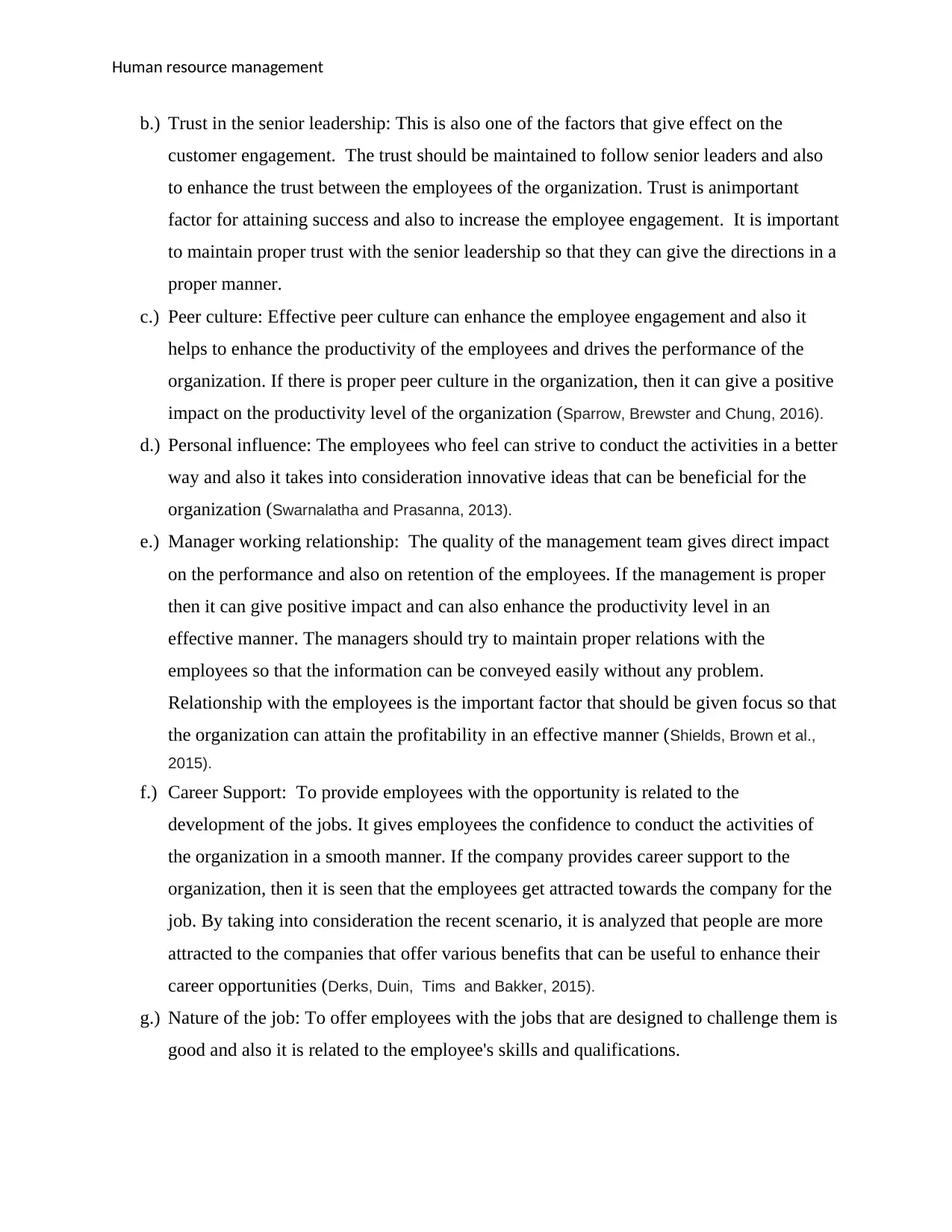
Human resource management
b.) Trust in the senior leadership: This is also one of the factors that give effect on the
customer engagement. The trust should be maintained to follow senior leaders and also
to enhance the trust between the employees of the organization. Trust is animportant
factor for attaining success and also to increase the employee engagement. It is important
to maintain proper trust with the senior leadership so that they can give the directions in a
proper manner.
c.) Peer culture: Effective peer culture can enhance the employee engagement and also it
helps to enhance the productivity of the employees and drives the performance of the
organization. If there is proper peer culture in the organization, then it can give a positive
impact on the productivity level of the organization (Sparrow, Brewster and Chung, 2016).
d.) Personal influence: The employees who feel can strive to conduct the activities in a better
way and also it takes into consideration innovative ideas that can be beneficial for the
organization (Swarnalatha and Prasanna, 2013).
e.) Manager working relationship: The quality of the management team gives direct impact
on the performance and also on retention of the employees. If the management is proper
then it can give positive impact and can also enhance the productivity level in an
effective manner. The managers should try to maintain proper relations with the
employees so that the information can be conveyed easily without any problem.
Relationship with the employees is the important factor that should be given focus so that
the organization can attain the profitability in an effective manner (Shields, Brown et al.,
2015).
f.) Career Support: To provide employees with the opportunity is related to the
development of the jobs. It gives employees the confidence to conduct the activities of
the organization in a smooth manner. If the company provides career support to the
organization, then it is seen that the employees get attracted towards the company for the
job. By taking into consideration the recent scenario, it is analyzed that people are more
attracted to the companies that offer various benefits that can be useful to enhance their
career opportunities (Derks, Duin, Tims and Bakker, 2015).
g.) Nature of the job: To offer employees with the jobs that are designed to challenge them is
good and also it is related to the employee's skills and qualifications.
b.) Trust in the senior leadership: This is also one of the factors that give effect on the
customer engagement. The trust should be maintained to follow senior leaders and also
to enhance the trust between the employees of the organization. Trust is animportant
factor for attaining success and also to increase the employee engagement. It is important
to maintain proper trust with the senior leadership so that they can give the directions in a
proper manner.
c.) Peer culture: Effective peer culture can enhance the employee engagement and also it
helps to enhance the productivity of the employees and drives the performance of the
organization. If there is proper peer culture in the organization, then it can give a positive
impact on the productivity level of the organization (Sparrow, Brewster and Chung, 2016).
d.) Personal influence: The employees who feel can strive to conduct the activities in a better
way and also it takes into consideration innovative ideas that can be beneficial for the
organization (Swarnalatha and Prasanna, 2013).
e.) Manager working relationship: The quality of the management team gives direct impact
on the performance and also on retention of the employees. If the management is proper
then it can give positive impact and can also enhance the productivity level in an
effective manner. The managers should try to maintain proper relations with the
employees so that the information can be conveyed easily without any problem.
Relationship with the employees is the important factor that should be given focus so that
the organization can attain the profitability in an effective manner (Shields, Brown et al.,
2015).
f.) Career Support: To provide employees with the opportunity is related to the
development of the jobs. It gives employees the confidence to conduct the activities of
the organization in a smooth manner. If the company provides career support to the
organization, then it is seen that the employees get attracted towards the company for the
job. By taking into consideration the recent scenario, it is analyzed that people are more
attracted to the companies that offer various benefits that can be useful to enhance their
career opportunities (Derks, Duin, Tims and Bakker, 2015).
g.) Nature of the job: To offer employees with the jobs that are designed to challenge them is
good and also it is related to the employee's skills and qualifications.
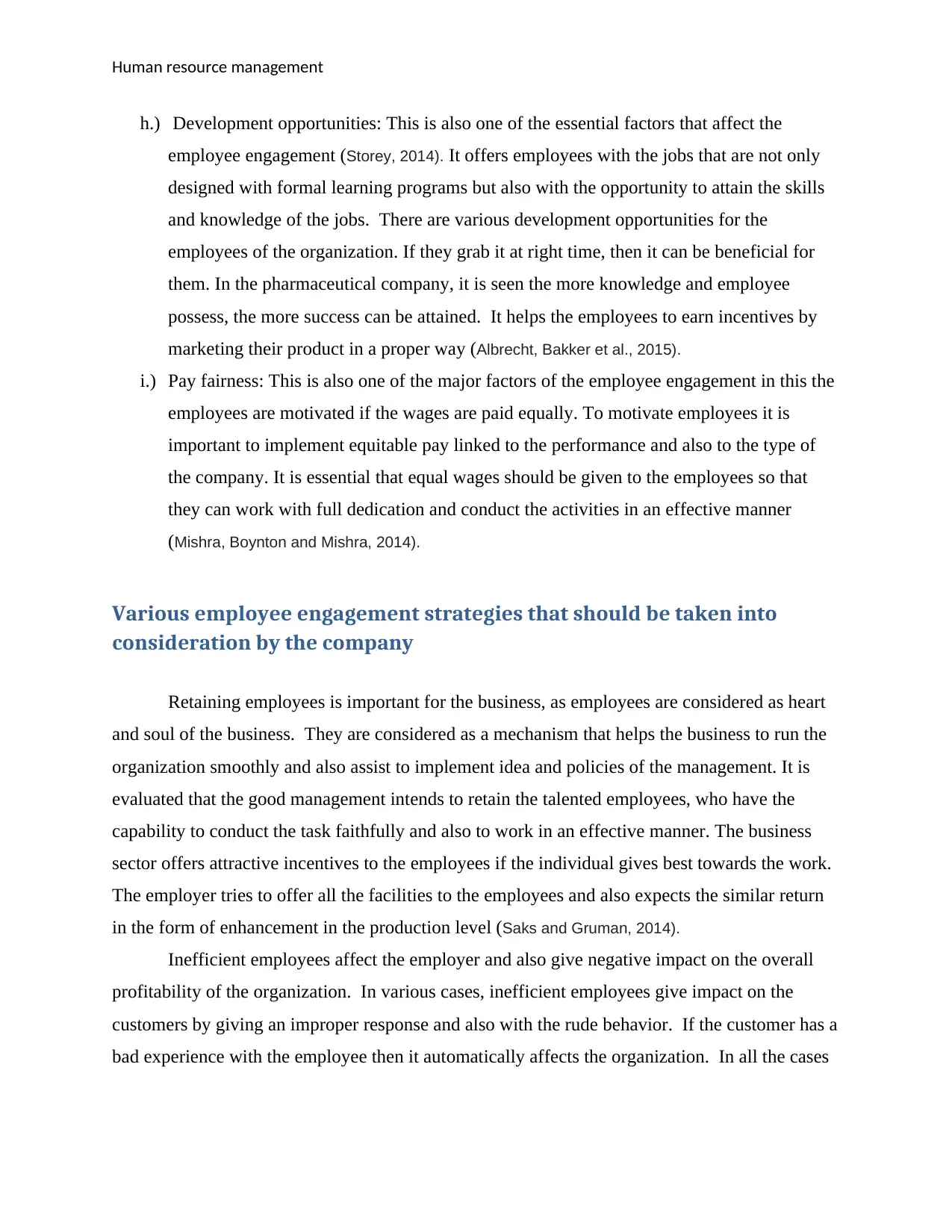
Human resource management
h.) Development opportunities: This is also one of the essential factors that affect the
employee engagement (Storey, 2014). It offers employees with the jobs that are not only
designed with formal learning programs but also with the opportunity to attain the skills
and knowledge of the jobs. There are various development opportunities for the
employees of the organization. If they grab it at right time, then it can be beneficial for
them. In the pharmaceutical company, it is seen the more knowledge and employee
possess, the more success can be attained. It helps the employees to earn incentives by
marketing their product in a proper way (Albrecht, Bakker et al., 2015).
i.) Pay fairness: This is also one of the major factors of the employee engagement in this the
employees are motivated if the wages are paid equally. To motivate employees it is
important to implement equitable pay linked to the performance and also to the type of
the company. It is essential that equal wages should be given to the employees so that
they can work with full dedication and conduct the activities in an effective manner
(Mishra, Boynton and Mishra, 2014).
Various employee engagement strategies that should be taken into
consideration by the company
Retaining employees is important for the business, as employees are considered as heart
and soul of the business. They are considered as a mechanism that helps the business to run the
organization smoothly and also assist to implement idea and policies of the management. It is
evaluated that the good management intends to retain the talented employees, who have the
capability to conduct the task faithfully and also to work in an effective manner. The business
sector offers attractive incentives to the employees if the individual gives best towards the work.
The employer tries to offer all the facilities to the employees and also expects the similar return
in the form of enhancement in the production level (Saks and Gruman, 2014).
Inefficient employees affect the employer and also give negative impact on the overall
profitability of the organization. In various cases, inefficient employees give impact on the
customers by giving an improper response and also with the rude behavior. If the customer has a
bad experience with the employee then it automatically affects the organization. In all the cases
h.) Development opportunities: This is also one of the essential factors that affect the
employee engagement (Storey, 2014). It offers employees with the jobs that are not only
designed with formal learning programs but also with the opportunity to attain the skills
and knowledge of the jobs. There are various development opportunities for the
employees of the organization. If they grab it at right time, then it can be beneficial for
them. In the pharmaceutical company, it is seen the more knowledge and employee
possess, the more success can be attained. It helps the employees to earn incentives by
marketing their product in a proper way (Albrecht, Bakker et al., 2015).
i.) Pay fairness: This is also one of the major factors of the employee engagement in this the
employees are motivated if the wages are paid equally. To motivate employees it is
important to implement equitable pay linked to the performance and also to the type of
the company. It is essential that equal wages should be given to the employees so that
they can work with full dedication and conduct the activities in an effective manner
(Mishra, Boynton and Mishra, 2014).
Various employee engagement strategies that should be taken into
consideration by the company
Retaining employees is important for the business, as employees are considered as heart
and soul of the business. They are considered as a mechanism that helps the business to run the
organization smoothly and also assist to implement idea and policies of the management. It is
evaluated that the good management intends to retain the talented employees, who have the
capability to conduct the task faithfully and also to work in an effective manner. The business
sector offers attractive incentives to the employees if the individual gives best towards the work.
The employer tries to offer all the facilities to the employees and also expects the similar return
in the form of enhancement in the production level (Saks and Gruman, 2014).
Inefficient employees affect the employer and also give negative impact on the overall
profitability of the organization. In various cases, inefficient employees give impact on the
customers by giving an improper response and also with the rude behavior. If the customer has a
bad experience with the employee then it automatically affects the organization. In all the cases
⊘ This is a preview!⊘
Do you want full access?
Subscribe today to unlock all pages.

Trusted by 1+ million students worldwide
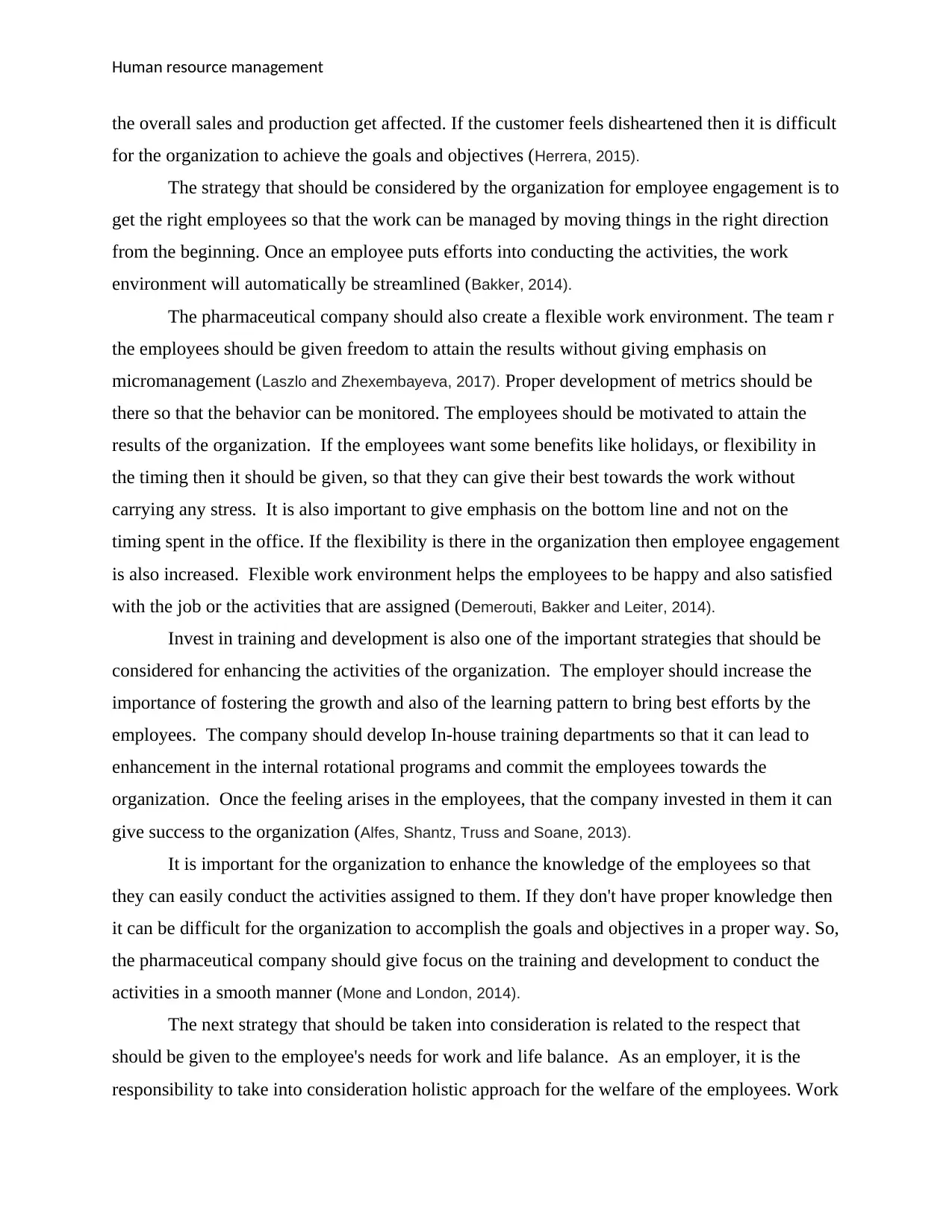
Human resource management
the overall sales and production get affected. If the customer feels disheartened then it is difficult
for the organization to achieve the goals and objectives (Herrera, 2015).
The strategy that should be considered by the organization for employee engagement is to
get the right employees so that the work can be managed by moving things in the right direction
from the beginning. Once an employee puts efforts into conducting the activities, the work
environment will automatically be streamlined (Bakker, 2014).
The pharmaceutical company should also create a flexible work environment. The team r
the employees should be given freedom to attain the results without giving emphasis on
micromanagement (Laszlo and Zhexembayeva, 2017). Proper development of metrics should be
there so that the behavior can be monitored. The employees should be motivated to attain the
results of the organization. If the employees want some benefits like holidays, or flexibility in
the timing then it should be given, so that they can give their best towards the work without
carrying any stress. It is also important to give emphasis on the bottom line and not on the
timing spent in the office. If the flexibility is there in the organization then employee engagement
is also increased. Flexible work environment helps the employees to be happy and also satisfied
with the job or the activities that are assigned (Demerouti, Bakker and Leiter, 2014).
Invest in training and development is also one of the important strategies that should be
considered for enhancing the activities of the organization. The employer should increase the
importance of fostering the growth and also of the learning pattern to bring best efforts by the
employees. The company should develop In-house training departments so that it can lead to
enhancement in the internal rotational programs and commit the employees towards the
organization. Once the feeling arises in the employees, that the company invested in them it can
give success to the organization (Alfes, Shantz, Truss and Soane, 2013).
It is important for the organization to enhance the knowledge of the employees so that
they can easily conduct the activities assigned to them. If they don't have proper knowledge then
it can be difficult for the organization to accomplish the goals and objectives in a proper way. So,
the pharmaceutical company should give focus on the training and development to conduct the
activities in a smooth manner (Mone and London, 2014).
The next strategy that should be taken into consideration is related to the respect that
should be given to the employee's needs for work and life balance. As an employer, it is the
responsibility to take into consideration holistic approach for the welfare of the employees. Work
the overall sales and production get affected. If the customer feels disheartened then it is difficult
for the organization to achieve the goals and objectives (Herrera, 2015).
The strategy that should be considered by the organization for employee engagement is to
get the right employees so that the work can be managed by moving things in the right direction
from the beginning. Once an employee puts efforts into conducting the activities, the work
environment will automatically be streamlined (Bakker, 2014).
The pharmaceutical company should also create a flexible work environment. The team r
the employees should be given freedom to attain the results without giving emphasis on
micromanagement (Laszlo and Zhexembayeva, 2017). Proper development of metrics should be
there so that the behavior can be monitored. The employees should be motivated to attain the
results of the organization. If the employees want some benefits like holidays, or flexibility in
the timing then it should be given, so that they can give their best towards the work without
carrying any stress. It is also important to give emphasis on the bottom line and not on the
timing spent in the office. If the flexibility is there in the organization then employee engagement
is also increased. Flexible work environment helps the employees to be happy and also satisfied
with the job or the activities that are assigned (Demerouti, Bakker and Leiter, 2014).
Invest in training and development is also one of the important strategies that should be
considered for enhancing the activities of the organization. The employer should increase the
importance of fostering the growth and also of the learning pattern to bring best efforts by the
employees. The company should develop In-house training departments so that it can lead to
enhancement in the internal rotational programs and commit the employees towards the
organization. Once the feeling arises in the employees, that the company invested in them it can
give success to the organization (Alfes, Shantz, Truss and Soane, 2013).
It is important for the organization to enhance the knowledge of the employees so that
they can easily conduct the activities assigned to them. If they don't have proper knowledge then
it can be difficult for the organization to accomplish the goals and objectives in a proper way. So,
the pharmaceutical company should give focus on the training and development to conduct the
activities in a smooth manner (Mone and London, 2014).
The next strategy that should be taken into consideration is related to the respect that
should be given to the employee's needs for work and life balance. As an employer, it is the
responsibility to take into consideration holistic approach for the welfare of the employees. Work
Paraphrase This Document
Need a fresh take? Get an instant paraphrase of this document with our AI Paraphraser
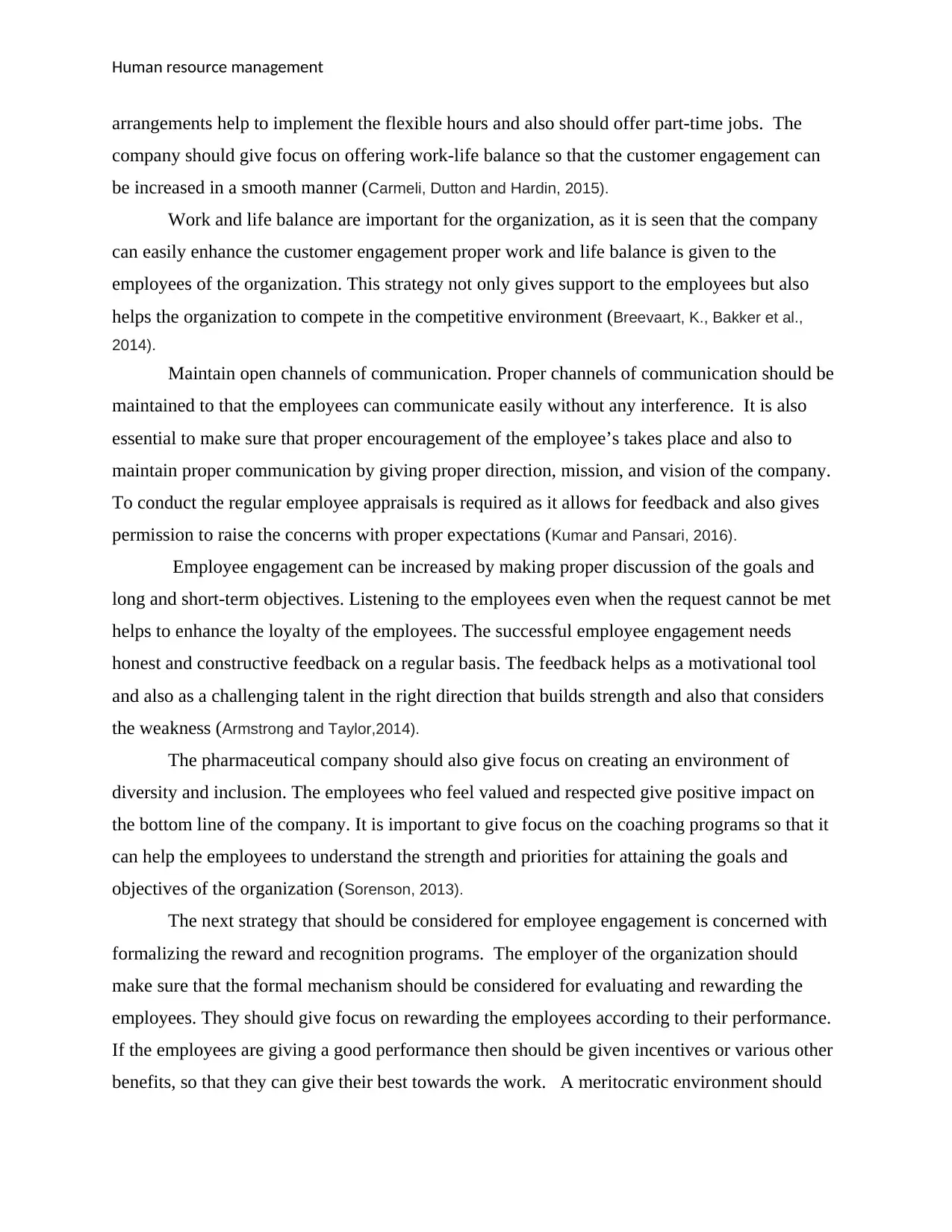
Human resource management
arrangements help to implement the flexible hours and also should offer part-time jobs. The
company should give focus on offering work-life balance so that the customer engagement can
be increased in a smooth manner (Carmeli, Dutton and Hardin, 2015).
Work and life balance are important for the organization, as it is seen that the company
can easily enhance the customer engagement proper work and life balance is given to the
employees of the organization. This strategy not only gives support to the employees but also
helps the organization to compete in the competitive environment (Breevaart, K., Bakker et al.,
2014).
Maintain open channels of communication. Proper channels of communication should be
maintained to that the employees can communicate easily without any interference. It is also
essential to make sure that proper encouragement of the employee’s takes place and also to
maintain proper communication by giving proper direction, mission, and vision of the company.
To conduct the regular employee appraisals is required as it allows for feedback and also gives
permission to raise the concerns with proper expectations (Kumar and Pansari, 2016).
Employee engagement can be increased by making proper discussion of the goals and
long and short-term objectives. Listening to the employees even when the request cannot be met
helps to enhance the loyalty of the employees. The successful employee engagement needs
honest and constructive feedback on a regular basis. The feedback helps as a motivational tool
and also as a challenging talent in the right direction that builds strength and also that considers
the weakness (Armstrong and Taylor,2014).
The pharmaceutical company should also give focus on creating an environment of
diversity and inclusion. The employees who feel valued and respected give positive impact on
the bottom line of the company. It is important to give focus on the coaching programs so that it
can help the employees to understand the strength and priorities for attaining the goals and
objectives of the organization (Sorenson, 2013).
The next strategy that should be considered for employee engagement is concerned with
formalizing the reward and recognition programs. The employer of the organization should
make sure that the formal mechanism should be considered for evaluating and rewarding the
employees. They should give focus on rewarding the employees according to their performance.
If the employees are giving a good performance then should be given incentives or various other
benefits, so that they can give their best towards the work. A meritocratic environment should
arrangements help to implement the flexible hours and also should offer part-time jobs. The
company should give focus on offering work-life balance so that the customer engagement can
be increased in a smooth manner (Carmeli, Dutton and Hardin, 2015).
Work and life balance are important for the organization, as it is seen that the company
can easily enhance the customer engagement proper work and life balance is given to the
employees of the organization. This strategy not only gives support to the employees but also
helps the organization to compete in the competitive environment (Breevaart, K., Bakker et al.,
2014).
Maintain open channels of communication. Proper channels of communication should be
maintained to that the employees can communicate easily without any interference. It is also
essential to make sure that proper encouragement of the employee’s takes place and also to
maintain proper communication by giving proper direction, mission, and vision of the company.
To conduct the regular employee appraisals is required as it allows for feedback and also gives
permission to raise the concerns with proper expectations (Kumar and Pansari, 2016).
Employee engagement can be increased by making proper discussion of the goals and
long and short-term objectives. Listening to the employees even when the request cannot be met
helps to enhance the loyalty of the employees. The successful employee engagement needs
honest and constructive feedback on a regular basis. The feedback helps as a motivational tool
and also as a challenging talent in the right direction that builds strength and also that considers
the weakness (Armstrong and Taylor,2014).
The pharmaceutical company should also give focus on creating an environment of
diversity and inclusion. The employees who feel valued and respected give positive impact on
the bottom line of the company. It is important to give focus on the coaching programs so that it
can help the employees to understand the strength and priorities for attaining the goals and
objectives of the organization (Sorenson, 2013).
The next strategy that should be considered for employee engagement is concerned with
formalizing the reward and recognition programs. The employer of the organization should
make sure that the formal mechanism should be considered for evaluating and rewarding the
employees. They should give focus on rewarding the employees according to their performance.
If the employees are giving a good performance then should be given incentives or various other
benefits, so that they can give their best towards the work. A meritocratic environment should
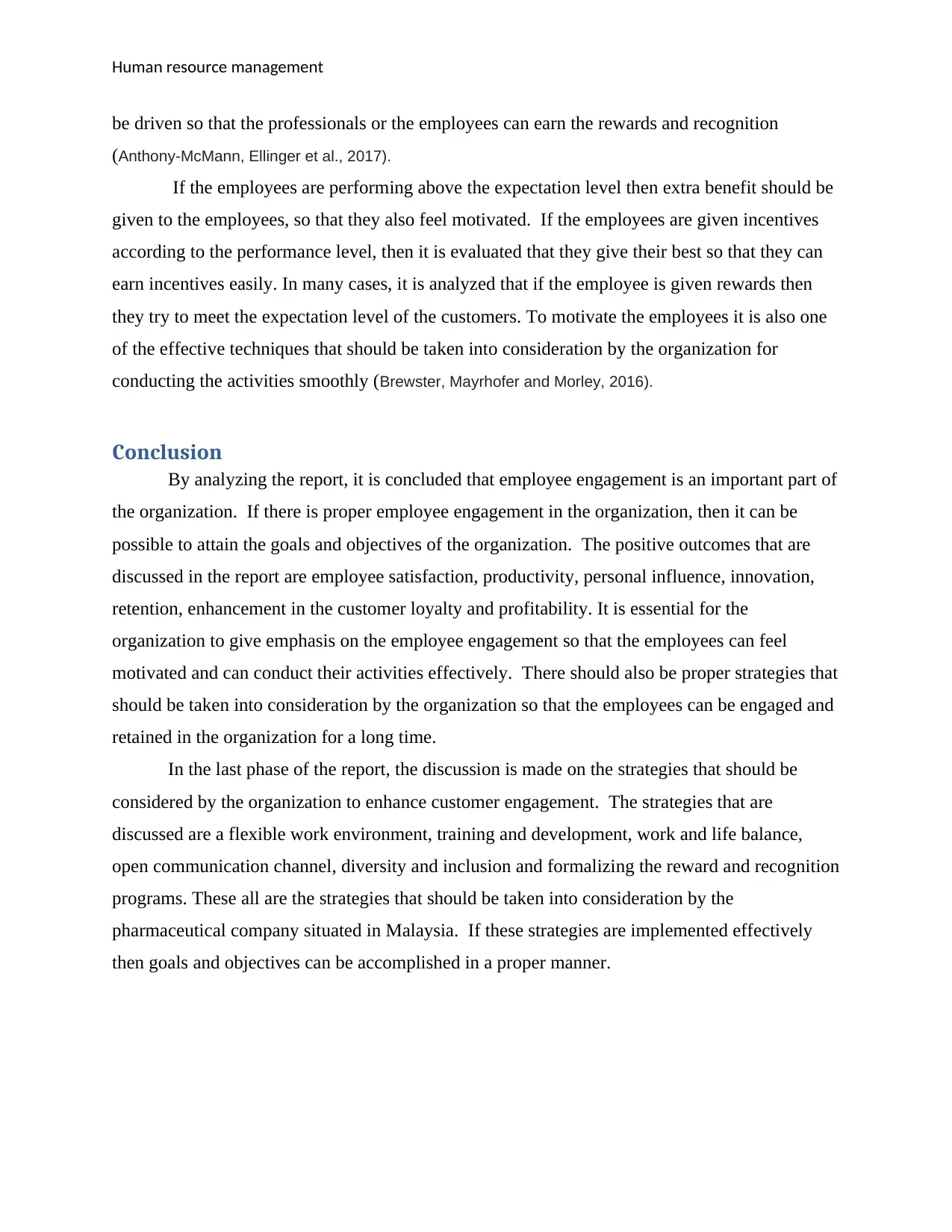
Human resource management
be driven so that the professionals or the employees can earn the rewards and recognition
(Anthony‐McMann, Ellinger et al., 2017).
If the employees are performing above the expectation level then extra benefit should be
given to the employees, so that they also feel motivated. If the employees are given incentives
according to the performance level, then it is evaluated that they give their best so that they can
earn incentives easily. In many cases, it is analyzed that if the employee is given rewards then
they try to meet the expectation level of the customers. To motivate the employees it is also one
of the effective techniques that should be taken into consideration by the organization for
conducting the activities smoothly (Brewster, Mayrhofer and Morley, 2016).
Conclusion
By analyzing the report, it is concluded that employee engagement is an important part of
the organization. If there is proper employee engagement in the organization, then it can be
possible to attain the goals and objectives of the organization. The positive outcomes that are
discussed in the report are employee satisfaction, productivity, personal influence, innovation,
retention, enhancement in the customer loyalty and profitability. It is essential for the
organization to give emphasis on the employee engagement so that the employees can feel
motivated and can conduct their activities effectively. There should also be proper strategies that
should be taken into consideration by the organization so that the employees can be engaged and
retained in the organization for a long time.
In the last phase of the report, the discussion is made on the strategies that should be
considered by the organization to enhance customer engagement. The strategies that are
discussed are a flexible work environment, training and development, work and life balance,
open communication channel, diversity and inclusion and formalizing the reward and recognition
programs. These all are the strategies that should be taken into consideration by the
pharmaceutical company situated in Malaysia. If these strategies are implemented effectively
then goals and objectives can be accomplished in a proper manner.
be driven so that the professionals or the employees can earn the rewards and recognition
(Anthony‐McMann, Ellinger et al., 2017).
If the employees are performing above the expectation level then extra benefit should be
given to the employees, so that they also feel motivated. If the employees are given incentives
according to the performance level, then it is evaluated that they give their best so that they can
earn incentives easily. In many cases, it is analyzed that if the employee is given rewards then
they try to meet the expectation level of the customers. To motivate the employees it is also one
of the effective techniques that should be taken into consideration by the organization for
conducting the activities smoothly (Brewster, Mayrhofer and Morley, 2016).
Conclusion
By analyzing the report, it is concluded that employee engagement is an important part of
the organization. If there is proper employee engagement in the organization, then it can be
possible to attain the goals and objectives of the organization. The positive outcomes that are
discussed in the report are employee satisfaction, productivity, personal influence, innovation,
retention, enhancement in the customer loyalty and profitability. It is essential for the
organization to give emphasis on the employee engagement so that the employees can feel
motivated and can conduct their activities effectively. There should also be proper strategies that
should be taken into consideration by the organization so that the employees can be engaged and
retained in the organization for a long time.
In the last phase of the report, the discussion is made on the strategies that should be
considered by the organization to enhance customer engagement. The strategies that are
discussed are a flexible work environment, training and development, work and life balance,
open communication channel, diversity and inclusion and formalizing the reward and recognition
programs. These all are the strategies that should be taken into consideration by the
pharmaceutical company situated in Malaysia. If these strategies are implemented effectively
then goals and objectives can be accomplished in a proper manner.
⊘ This is a preview!⊘
Do you want full access?
Subscribe today to unlock all pages.

Trusted by 1+ million students worldwide
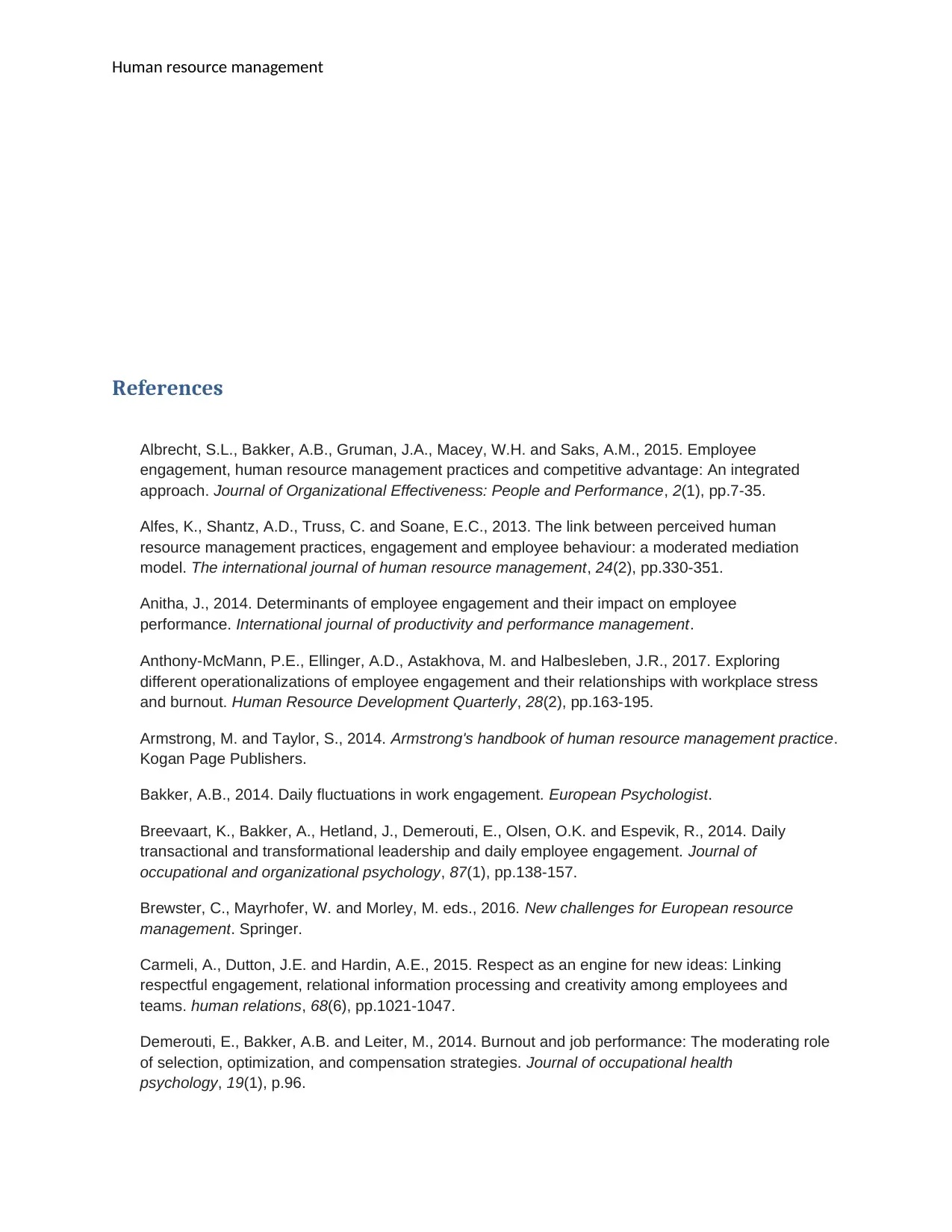
Human resource management
References
Albrecht, S.L., Bakker, A.B., Gruman, J.A., Macey, W.H. and Saks, A.M., 2015. Employee
engagement, human resource management practices and competitive advantage: An integrated
approach. Journal of Organizational Effectiveness: People and Performance, 2(1), pp.7-35.
Alfes, K., Shantz, A.D., Truss, C. and Soane, E.C., 2013. The link between perceived human
resource management practices, engagement and employee behaviour: a moderated mediation
model. The international journal of human resource management, 24(2), pp.330-351.
Anitha, J., 2014. Determinants of employee engagement and their impact on employee
performance. International journal of productivity and performance management.
Anthony‐McMann, P.E., Ellinger, A.D., Astakhova, M. and Halbesleben, J.R., 2017. Exploring
different operationalizations of employee engagement and their relationships with workplace stress
and burnout. Human Resource Development Quarterly, 28(2), pp.163-195.
Armstrong, M. and Taylor, S., 2014. Armstrong's handbook of human resource management practice.
Kogan Page Publishers.
Bakker, A.B., 2014. Daily fluctuations in work engagement. European Psychologist.
Breevaart, K., Bakker, A., Hetland, J., Demerouti, E., Olsen, O.K. and Espevik, R., 2014. Daily
transactional and transformational leadership and daily employee engagement. Journal of
occupational and organizational psychology, 87(1), pp.138-157.
Brewster, C., Mayrhofer, W. and Morley, M. eds., 2016. New challenges for European resource
management. Springer.
Carmeli, A., Dutton, J.E. and Hardin, A.E., 2015. Respect as an engine for new ideas: Linking
respectful engagement, relational information processing and creativity among employees and
teams. human relations, 68(6), pp.1021-1047.
Demerouti, E., Bakker, A.B. and Leiter, M., 2014. Burnout and job performance: The moderating role
of selection, optimization, and compensation strategies. Journal of occupational health
psychology, 19(1), p.96.
References
Albrecht, S.L., Bakker, A.B., Gruman, J.A., Macey, W.H. and Saks, A.M., 2015. Employee
engagement, human resource management practices and competitive advantage: An integrated
approach. Journal of Organizational Effectiveness: People and Performance, 2(1), pp.7-35.
Alfes, K., Shantz, A.D., Truss, C. and Soane, E.C., 2013. The link between perceived human
resource management practices, engagement and employee behaviour: a moderated mediation
model. The international journal of human resource management, 24(2), pp.330-351.
Anitha, J., 2014. Determinants of employee engagement and their impact on employee
performance. International journal of productivity and performance management.
Anthony‐McMann, P.E., Ellinger, A.D., Astakhova, M. and Halbesleben, J.R., 2017. Exploring
different operationalizations of employee engagement and their relationships with workplace stress
and burnout. Human Resource Development Quarterly, 28(2), pp.163-195.
Armstrong, M. and Taylor, S., 2014. Armstrong's handbook of human resource management practice.
Kogan Page Publishers.
Bakker, A.B., 2014. Daily fluctuations in work engagement. European Psychologist.
Breevaart, K., Bakker, A., Hetland, J., Demerouti, E., Olsen, O.K. and Espevik, R., 2014. Daily
transactional and transformational leadership and daily employee engagement. Journal of
occupational and organizational psychology, 87(1), pp.138-157.
Brewster, C., Mayrhofer, W. and Morley, M. eds., 2016. New challenges for European resource
management. Springer.
Carmeli, A., Dutton, J.E. and Hardin, A.E., 2015. Respect as an engine for new ideas: Linking
respectful engagement, relational information processing and creativity among employees and
teams. human relations, 68(6), pp.1021-1047.
Demerouti, E., Bakker, A.B. and Leiter, M., 2014. Burnout and job performance: The moderating role
of selection, optimization, and compensation strategies. Journal of occupational health
psychology, 19(1), p.96.
Paraphrase This Document
Need a fresh take? Get an instant paraphrase of this document with our AI Paraphraser
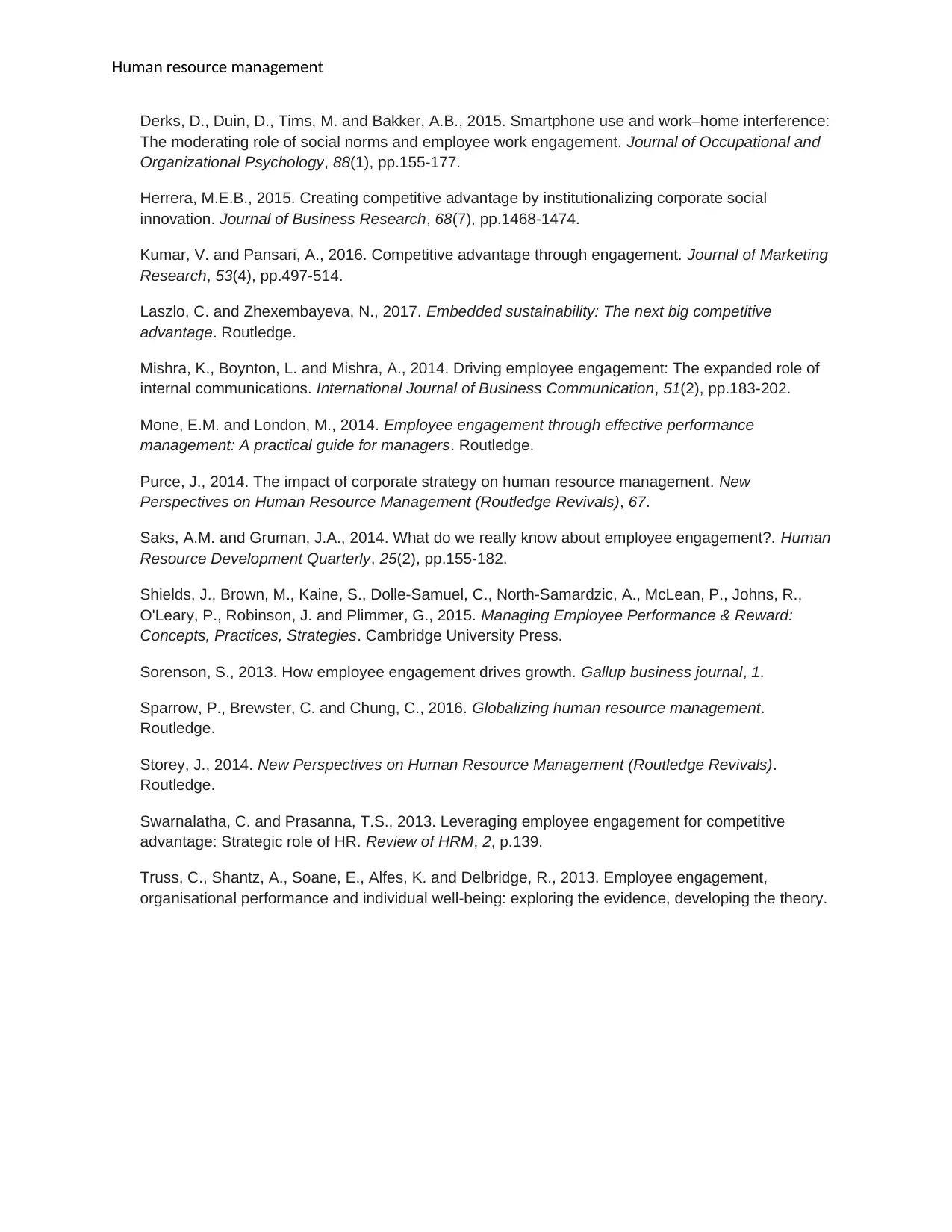
Human resource management
Derks, D., Duin, D., Tims, M. and Bakker, A.B., 2015. Smartphone use and work–home interference:
The moderating role of social norms and employee work engagement. Journal of Occupational and
Organizational Psychology, 88(1), pp.155-177.
Herrera, M.E.B., 2015. Creating competitive advantage by institutionalizing corporate social
innovation. Journal of Business Research, 68(7), pp.1468-1474.
Kumar, V. and Pansari, A., 2016. Competitive advantage through engagement. Journal of Marketing
Research, 53(4), pp.497-514.
Laszlo, C. and Zhexembayeva, N., 2017. Embedded sustainability: The next big competitive
advantage. Routledge.
Mishra, K., Boynton, L. and Mishra, A., 2014. Driving employee engagement: The expanded role of
internal communications. International Journal of Business Communication, 51(2), pp.183-202.
Mone, E.M. and London, M., 2014. Employee engagement through effective performance
management: A practical guide for managers. Routledge.
Purce, J., 2014. The impact of corporate strategy on human resource management. New
Perspectives on Human Resource Management (Routledge Revivals), 67.
Saks, A.M. and Gruman, J.A., 2014. What do we really know about employee engagement?. Human
Resource Development Quarterly, 25(2), pp.155-182.
Shields, J., Brown, M., Kaine, S., Dolle-Samuel, C., North-Samardzic, A., McLean, P., Johns, R.,
O'Leary, P., Robinson, J. and Plimmer, G., 2015. Managing Employee Performance & Reward:
Concepts, Practices, Strategies. Cambridge University Press.
Sorenson, S., 2013. How employee engagement drives growth. Gallup business journal, 1.
Sparrow, P., Brewster, C. and Chung, C., 2016. Globalizing human resource management.
Routledge.
Storey, J., 2014. New Perspectives on Human Resource Management (Routledge Revivals).
Routledge.
Swarnalatha, C. and Prasanna, T.S., 2013. Leveraging employee engagement for competitive
advantage: Strategic role of HR. Review of HRM, 2, p.139.
Truss, C., Shantz, A., Soane, E., Alfes, K. and Delbridge, R., 2013. Employee engagement,
organisational performance and individual well-being: exploring the evidence, developing the theory.
Derks, D., Duin, D., Tims, M. and Bakker, A.B., 2015. Smartphone use and work–home interference:
The moderating role of social norms and employee work engagement. Journal of Occupational and
Organizational Psychology, 88(1), pp.155-177.
Herrera, M.E.B., 2015. Creating competitive advantage by institutionalizing corporate social
innovation. Journal of Business Research, 68(7), pp.1468-1474.
Kumar, V. and Pansari, A., 2016. Competitive advantage through engagement. Journal of Marketing
Research, 53(4), pp.497-514.
Laszlo, C. and Zhexembayeva, N., 2017. Embedded sustainability: The next big competitive
advantage. Routledge.
Mishra, K., Boynton, L. and Mishra, A., 2014. Driving employee engagement: The expanded role of
internal communications. International Journal of Business Communication, 51(2), pp.183-202.
Mone, E.M. and London, M., 2014. Employee engagement through effective performance
management: A practical guide for managers. Routledge.
Purce, J., 2014. The impact of corporate strategy on human resource management. New
Perspectives on Human Resource Management (Routledge Revivals), 67.
Saks, A.M. and Gruman, J.A., 2014. What do we really know about employee engagement?. Human
Resource Development Quarterly, 25(2), pp.155-182.
Shields, J., Brown, M., Kaine, S., Dolle-Samuel, C., North-Samardzic, A., McLean, P., Johns, R.,
O'Leary, P., Robinson, J. and Plimmer, G., 2015. Managing Employee Performance & Reward:
Concepts, Practices, Strategies. Cambridge University Press.
Sorenson, S., 2013. How employee engagement drives growth. Gallup business journal, 1.
Sparrow, P., Brewster, C. and Chung, C., 2016. Globalizing human resource management.
Routledge.
Storey, J., 2014. New Perspectives on Human Resource Management (Routledge Revivals).
Routledge.
Swarnalatha, C. and Prasanna, T.S., 2013. Leveraging employee engagement for competitive
advantage: Strategic role of HR. Review of HRM, 2, p.139.
Truss, C., Shantz, A., Soane, E., Alfes, K. and Delbridge, R., 2013. Employee engagement,
organisational performance and individual well-being: exploring the evidence, developing the theory.

Human resource management
⊘ This is a preview!⊘
Do you want full access?
Subscribe today to unlock all pages.

Trusted by 1+ million students worldwide
1 out of 12
Related Documents
Your All-in-One AI-Powered Toolkit for Academic Success.
+13062052269
info@desklib.com
Available 24*7 on WhatsApp / Email
![[object Object]](/_next/static/media/star-bottom.7253800d.svg)
Unlock your academic potential
Copyright © 2020–2025 A2Z Services. All Rights Reserved. Developed and managed by ZUCOL.




